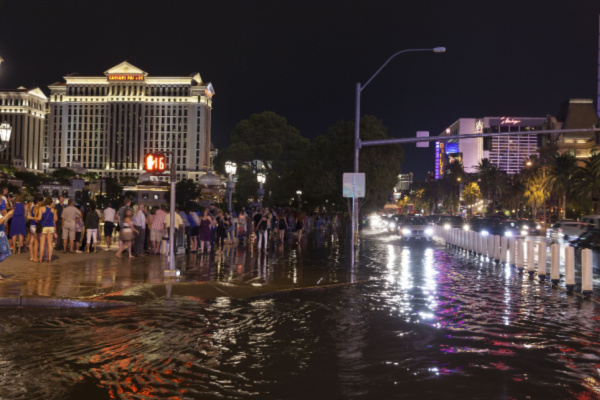After potent thunderstorms rolled through Las Vegas on Thursday night, portions of the iconic Las Vegas Strip were left under water as floodwaters poured into area casinos. As AccuWeather reports, the sky opened up across the Las Vegas metro area, and heavy rainfall turned streets and sidewalks along the iconic Las Vegas Strip into raging rivers as flash flooding developed.
Some visitors to Sin City were left stranded or scrambling to seek shelter as severe thunderstorms rolled through the area. The National Weather Service office in Las Vegas reported wind gusts of up to 70 mph accompanied the storms that roared through the city. Water levels ranged from considerable ponding on popular walkways to several inches deep within the worst flooding on roads. Eyewitness video from the event showed vehicles driving through flooded roadways, sending waves of water rippling.
Water also flowed into a handful of popular casinos. Roof leaks allowed rain to fall in Caesars Palace while water gushed from behind video screens in Circa Resort & Casino. Elsewhere, a waterfall poured from the roof of Planet Hollywood. Across the city, the Las Vegas Fire & Rescue responded to a total of 330 calls for service on Thursday night, many related to the storm. At least seven people were rescued from swift water, Las Vegas Fire & Rescue confirmed on Twitter.
According to AccuWeather, Harry Reid International Airport, Las Vegas’ main air hub and the official climate reporting station for the city, is located about 5 miles south of downtown Las Vegas. The airport picked up 0.32 of an inch of rain from Thursday night’s storms in just under two hours. On average, the airport typically records about a third of an inch of rainfall throughout the entirety of July. While the airport recorded about its monthly rainfall in just two hours, parts of downtown Las Vegas picked up double or even triple that amount of rain in the same length of time.
While these amounts may seem very small to residents in Kentucky and the eastern United States dealing with devastating flooding, almost any amount of rain in the West’s desert climate can be enough to trigger significant impacts. “It doesn’t take much rain to cause flash flooding problems in this part of the country, especially when the rain comes down fast and furious,” AccuWeather Meteorologist Reneé Duff said. “In Las Vegas, all it took was 0.29 of an inch of rain falling in an hour’s time to cause vehicles to become stranded in the streets on Thursday night.”
Additional storms were seen in the area yet again Friday evening, prompting the issuance of a Severe Thunderstorm Warning for most of the Las Vegas metro area. Fortunately, however, the city was spared from the heavy rain. Only 0.03 of an inch was recorded at the airport, and amounts generally remained around a quarter inch or less throughout the city. Strong and gusty winds did arrive again though, with a wind gust to 52 mph at the airport.
This weather pastern battering southern Nevada, Arizona, and across much of the Southwest is what is known as the North American monsoon. The monsoon generally marks a time of much-needed rain for the parched region. Of course, while flooding has wreaked havoc in Las Vegas, climatologists welcome the much needed rainfall in their drought ravaged region. Any and all precipitation will help alleviate the historically low water levels in nearby Lake Mead.
“Heading into the first week of August, there will likely be a decrease in thunderstorm activity across the region as drier air works its way into the atmosphere,” Duff explained. “Downpours are still likely to be scattered about in the high terrain, but aerial coverage should decrease.”
—
Photo Credit: Jeffrey J Coleman / Shutterstock.com
